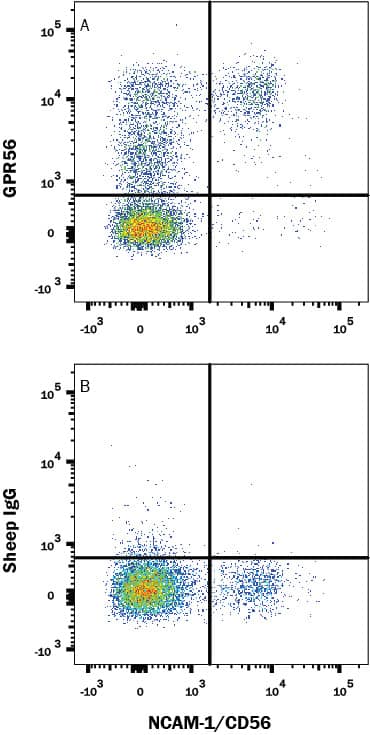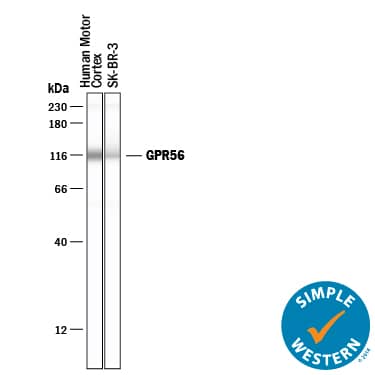Human GPR56 Antibody
R&D Systems, part of Bio-Techne | Catalog # AF4634


Key Product Details
Species Reactivity
Validated:
Cited:
Applications
Validated:
Cited:
Label
Antibody Source
Product Specifications
Immunogen
Arg26-Val342
Accession # AAP35975
Specificity
Clonality
Host
Isotype
Scientific Data Images for Human GPR56 Antibody
Detection of Human GPR56 by Western Blot.
Western blot shows lysates of human brain (cortex) tissue and human brain (hippocampus) tissue. PVDF membrane was probed with 1 µg/mL of Sheep Anti-Human GPR56 Antigen Affinity-purified Polyclonal Antibody (Catalog # AF4634) followed by HRP-conjugated Anti-Sheep IgG Secondary Antibody (Catalog # HAF016). A specific band was detected for GPR56 at approximately 65 kDa (as indicated). This experiment was conducted under reducing conditions and using Immunoblot Buffer Group 8.Detection of GPR56 in Human Blood Lymphocytes by Flow Cytometry.
Human peripheral blood lymphocytes were stained with (A) Sheep Anti-Human GPR56 Affinity-purified Polyclonal Antibody (Catalog # AF4634) or (B) control antibody (Catalog # 5-001-A), followed by Phycoerythrin-conjugated Anti-Sheep IgG Secondary Antibody (Catalog # F0126) and Mouse anti-Human CD56 APC-conjugated monoclonal antibody (Catalog # FAB2408A). View our protocol for Staining Membrane-associated Proteins.Detection of Human GPR56 by Simple WesternTM.
Simple Western lane view shows lysates of human brain (motor cortex) tissue and SK-BR-3 human breast cancer cell line, loaded at 0.2 mg/mL. A specific band was detected for GPR56 at approximately 116 kDa (as indicated) using 10 µg/mL of Sheep Anti-Human GPR56 Antigen Affinity-purified Polyclonal Antibody (Catalog # AF4634) followed by 1:50 dilution of HRP-conjugated Anti-Sheep IgG Secondary Antibody (Catalog # HAF016). This experiment was conducted under reducing conditions and using the 12-230 kDa separation system. Non-specific interaction with the 230 kDa Simple Western standard may be seen with this antibody.Applications for Human GPR56 Antibody
CyTOF-ready
Flow Cytometry
Sample:
| Human peripheral blood lymphocytes |
Simple Western
Sample: Human brain (motor cortex) tissue and SK‑BR‑3 human breast cancer cell line
Western Blot
Sample: Human brain (cortex) tissue and human brain (hippocampus) tissue
Reviewed Applications
Read 1 review rated 4 using AF4634 in the following applications:
Formulation, Preparation, and Storage
Purification
Reconstitution
Formulation
Shipping
Stability & Storage
- 12 months from date of receipt, -20 to -70 °C as supplied.
- 1 month, 2 to 8 °C under sterile conditions after reconstitution.
- 6 months, -20 to -70 °C under sterile conditions after reconstitution.
Background: GPR56
GPR56 is a member of the LN-TM7 family of adhesion-type 7-transmembrane (TM) G-protein coupled receptors (GPCR) with long extracellular N-termini (1‑3). The 693 amino acid (aa) human GPR56 contains a 25 aa signal sequence, a 377 aa N-terminal extracellular domain (ECD) and seven TM regions separated by short intracellular and extracellular regions. Like other LN-TM7 members, the ECD contains a highly glycosylated mucin-like stalk followed by a GPCR proteolytic cleavage site (GPS) (1, 4). Cleavage of the 60 kDa N-terminus from the 80 kDa full length form is needed for efficient cell surface expression (5, 6). While the cleaved portion may remain non-covalently associated, it has also been found in conditioned medium of cultured cells (5). Human GPR56 shares 71%, 72%, 80%, 80% and 79% aa identity with mouse, rat, canine, equine, and bovine GPR56 within the cleaved ECD. A functional splice variant lacking the GPS site and a non-functional splice variant lacking portions of the TM domains have also been described (4). A human brain developmental disorder, bilateral frontoparietal polymicrogyria, is associated with GPR56 mutations that also show impaired GPS cleavage, intracellular trafficking, and expression at the cell surface (5). GPR56 is widely distributed, with highest mRNA or expressed sequence tag expression in brain, thyroid, skin and female reproductive system (3, 4). GPR56 expression is upregulated during cell transformation and is high in melanomas, glioblastomas and astrocytomas, but downregulated in melanomas with high metastatic potential (2, 6‑8). Although the function of GPR56 is not completely known, it is clearly an adhesion protein (6‑8). Tissue transglutaminase (TG2) is one reported ligand, binding of which inhibits melanoma growth and metastasis (6). Association of GPR56 with the tetraspanin CD81 stabilizes its complex with Gaq/11 for cell signaling (9).
References
- Fredriksson, R. et al. (2002) FEBS Lett. 531:407.
- Zendman, A.J.W. et al. (1999) FEBS Lett. 446:292.
- Liu, M. et al. (1999) Genomics 55:296.
- Bjarnadottir, T.K. et al. (2007) Gene 387:38.
- Jin, Z. et al. (2007) Hum. Mol. Genet. 16:1972.
- Xu, L. et al. (2006) Proc. Natl. Acad. Sci. USA 103:9023.
- Shashidhar, S. et al. (2005) Oncogene 24:1673.
- Ke, N. et al. (2007) Mol. Cancer Ther. 6:1840.
- Little, K.D. et al. (2004) Mol. Biol. Cell 15:2375.
Long Name
Alternate Names
Gene Symbol
UniProt
Additional GPR56 Products
Product Documents for Human GPR56 Antibody
Product Specific Notices for Human GPR56 Antibody
For research use only

